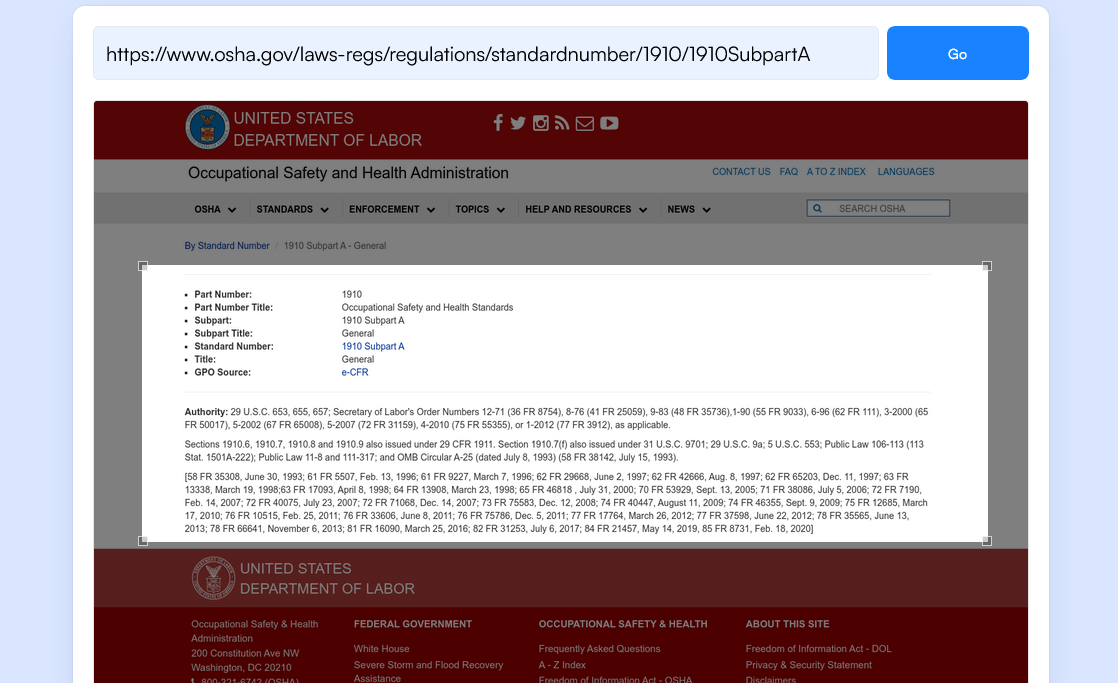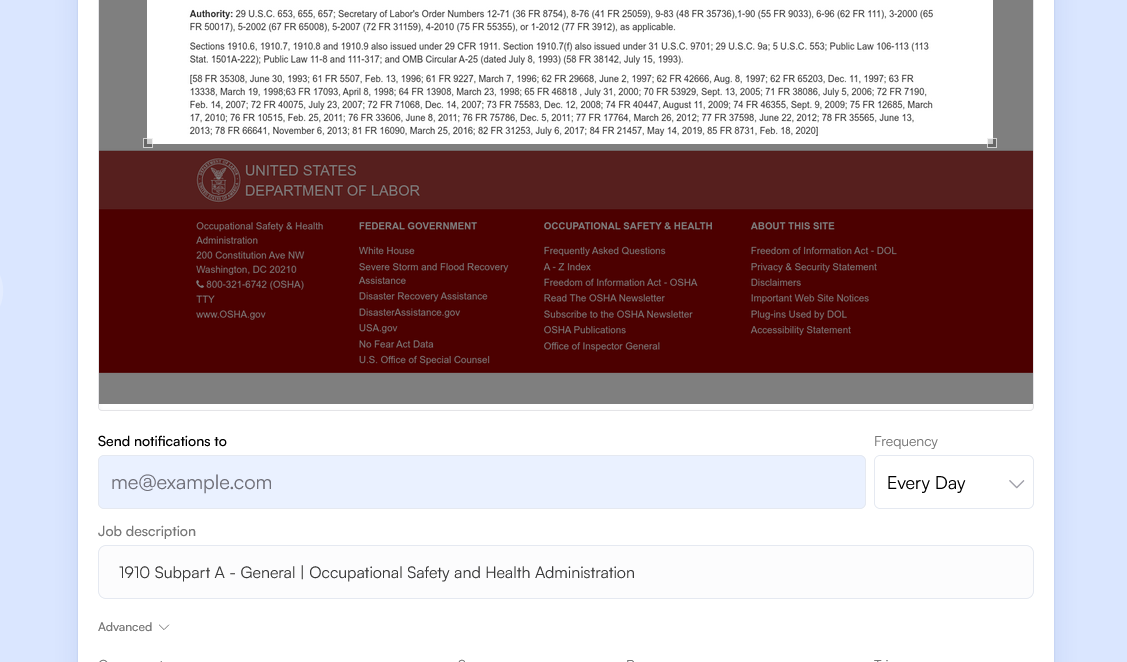How to Track Changing Legislation - Visualping
By Emily Fenton
Updated March 6, 2023

How to Keep Up with a Changing Regulatory Environment: Tracking Legislation
In a constantly changing regulatory environment, figuring out how to keep track of legislative updates can be tricky. And when you aren’t aware of a new regulatory change, you can’t start taking steps to ensure compliance.
Failing to comply with current regulations can result in hefty fines, sanctions, and other serious consequences. As such, staying abreast of changes is non-negotiable.
A new regulatory environment calls for a new tool. Visualping is a simple yet powerful program that tracks websites and lets you know any time there’s a change. If you’re wondering how to keep up with legislation changes, Visualping is a great place to start.
The Challenges of Keeping Up with Legislative and Regulatory Changes
If you want to maintain regulatory compliance, the first step to success is learning about changes before they happen.
Unfortunately, recent developments have made it more difficult for professionals in all industries to keep up with changes. Here are some of the factors complicating compliance.
The Decline of RSS Feeds
RSS feeds were once the main way legal and compliance professionals tracked regulatory changes. These feeds combined multiple website changes into a single file. With a quick scan, anyone could see how and when a website had changed.
Many organizations, including prominent regulatory agencies and news outlets, used to put out RSS feeds that made it easy to monitor legislation. However, the popularity of RSS feeds has drastically declined, taking away one of the primary tools for regulatory tracking.
Legal Databases Don’t Always Log the Debates that Transpire Between Events
If you’ve been looking into how to keep up with legislation changes, you may have begun closely following the Thomson-Reuters and LexisNexis databases. Since these databases keep track of the first, second, and third times a given bill passes through the legislature, they can be useful for regulatory tracking.
However, these databases aren’t perfect. For one thing, they don’t notify you of any debates surrounding the bills in question. They also have a time delay, meaning the updates you get aren’t in real-time.
Newsletters from Relevant Agencies Can Require Sifting Through a Bunch of Extraneous Information
Newsletters are good sources of information, and they often publish regulation-related news. But getting that information out of a newsletter is more tedious than it might seem.
Depending on your industry, you might find yourself tracking 10–20 (or even more) relevant agencies, waiting for their newsletters to arrive, then reading through them to find information on possible legislative changes.
Contacting Individual Agency Reps, Regulators, or Legislators Can Be Clunky and Time-Consuming
Reaching out to individual figures with knowledge of regulatory unfoldings might sound like a good idea in theory. After all, you might be able to hear about a potential bill before it makes the news.
However, this tactic is essentially like using your employees to do what regulatory intelligence software is intended to do, which makes the process labor-intensive and difficult to track. And if your team does it often enough, they might annoy a regulatory agency or two — not a great idea!
3 Ways to Keep Track of New Legislation in a Changing Regulatory Environment
To keep track of changes in today’s world, you need to think outside the box. Here are three modern ways you can accurately track regulatory changes.
Monitor Major Industry Websites and Publications for Announcements of New or Forthcoming Changes
Using a tool like Visualping to notify you of any changes on industry websites ensures that you know about potential changes as soon as possible.
You can follow regulatory agencies and industry-specific journals or other publications. For financial services compliance, for example, it’s a good idea to closely follow the FINRA (Financial Industry Regulatory Authority) website.
Stay in the Loop by Following Regulatory Agencies on Social Media
Social media isn’t just for posting selfies and seeing what your friends did over the weekend. It’s also a great way to stay current on new and upcoming regulatory changes.
Most major regulatory bodies have an active social media presence. You can easily follow the EPA (Environmental Protection Agency), FDA (Food and Drug Administration), DOT (Department of Transportation), and other agencies on Facebook, Twitter, and other social media platforms.
Subscribe to Industry Newsletters to Get the Latest News About Relevant Laws in Your Email Inbox
Figuring out how to maintain compliance with regulatory requirements starts with knowing about potential legislative changes before they happen. Luckily, potential changes usually appear in an industry-specific newsletter or two before they hit the news.
Most industry-specific newsletters aren’t solely dedicated to publishing stories about regulations, so you don’t want this to be your only method of tracking regulatory changes. That said, if you regularly get relevant newsletters sent to your inbox, you’ll have a better chance of spotting an upcoming legislative change.
One bonus of receiving these newsletters is that you may be able to see how others in your industry feel about upcoming changes. In some newsletters, writers will interview industry professionals to get their thoughts on regulation changes and other bits of industry news.
What to Monitor with Visualping
Visualping streamlines compliance monitoring so you can monitor with virtually no effort. Here are some of the sites legal knowledge professionals are monitoring:
- State Court Opinions and Orders
- Regional Court Daily Law Lists
- Federal Department of Health News
- District Court Standing Orders
- Federal Immigration Program Delivery Updates
- Federal Reserve Board Interpretations
- State Government Business Permits
- Federal Government Bills Progress
- Class Action Law Firm Case List
- EPA Requests for Public Comment
- Government Task Force “What’s New?” Page
- GDPR Enforcement Tracker
You can use Visualping to monitor all or part of a web page for changes. That way, you’ll only be notified about the portions that apply to you.
How to Use Visualping to Stay Alerted to New Legislative Changes
You don’t have to be a tech genius to use Visualping to monitor a website for changes. Here’s how to get started.
Step 1: Copy the URL of the Blog or Announcements Page from the Web, and Paste It into the Search Box on Visualping’s Website
Make sure you choose the specific page where news or updates are posted. Once you’ve selected the page, copy and paste the URL into the search box on Visualping’s website.
Step 2: Select the Part of the Page You Want to Monitor
As mentioned, you can monitor the entire webpage for changes or just a portion of it. You can also have Visualping watch for changes in text, images, or both.

Step 3: Decide How Often You Want Visualping to Scan the Page for New Changes
Depending on your plan, you can ask Visualping to check the page as often as every five minutes or as infrequently as every month.
Step 4: Enter the Email Address Where You Want to Receive Notifications
Provide an address you check frequently to ensure that you don’t miss a notification.

Step 5: Check Your Email to Complete the Signup Process and Start Tracking!
Once you’ve checked and verified your email, you can sit back and let Visualping do what it does best!
Never Miss a Regulatory Change
Keeping up with the changing regulatory environment has become progressively more difficult, but that doesn’t mean you have to be left behind. With Visualping, you can track hundreds of regulatory web pages with little effort. You’ll be informed the moment anything important changes.
Getting started with Visualping is quick and easy. Sign up today or reach out to one of our helpful team members to get started.
Get the latest legal knowledge
Sign up with Visualping for automatic legal and regulatory alerts, from any sources online.
Emily Fenton
Emily is the Product Marketing Manager at Visualping. She has a degree in English Literature and a Masters in Management. When she’s not researching and writing about all things Visualping, she loves exploring new restaurants, playing guitar and petting her cats